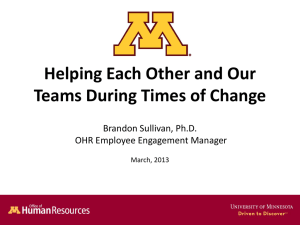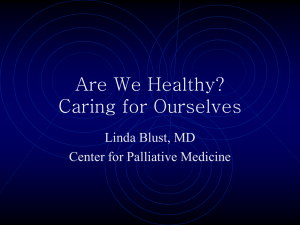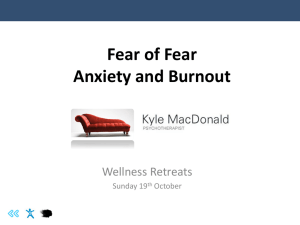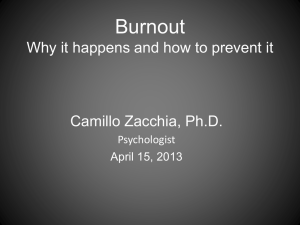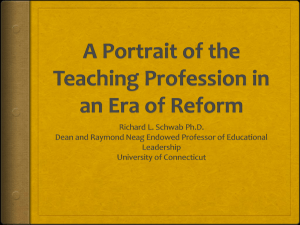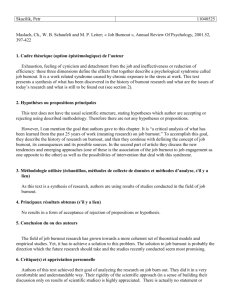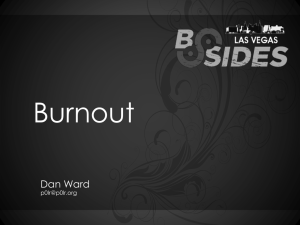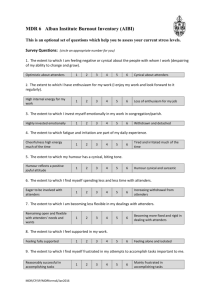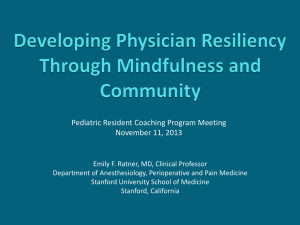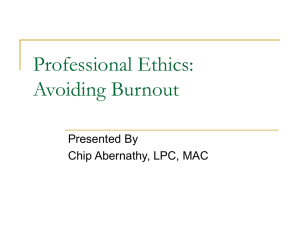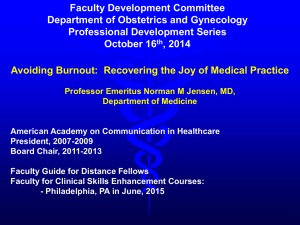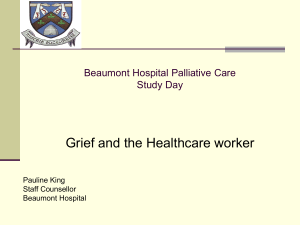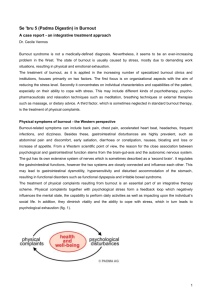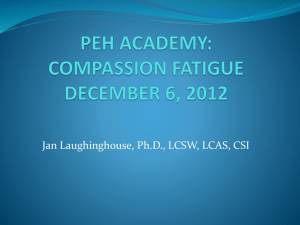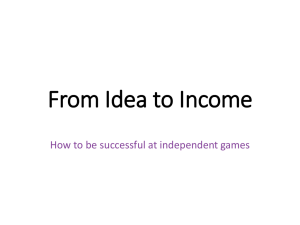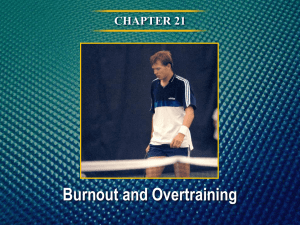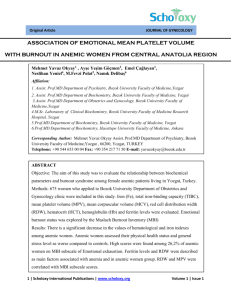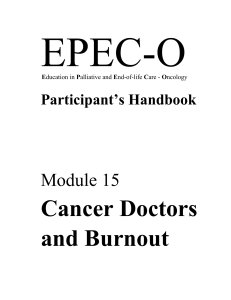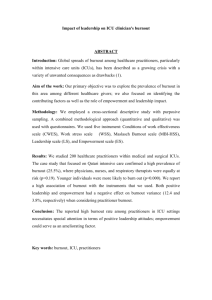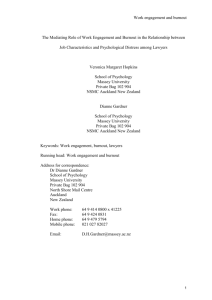Chief Resident Forum - Survival 101: Work Life Integration
advertisement
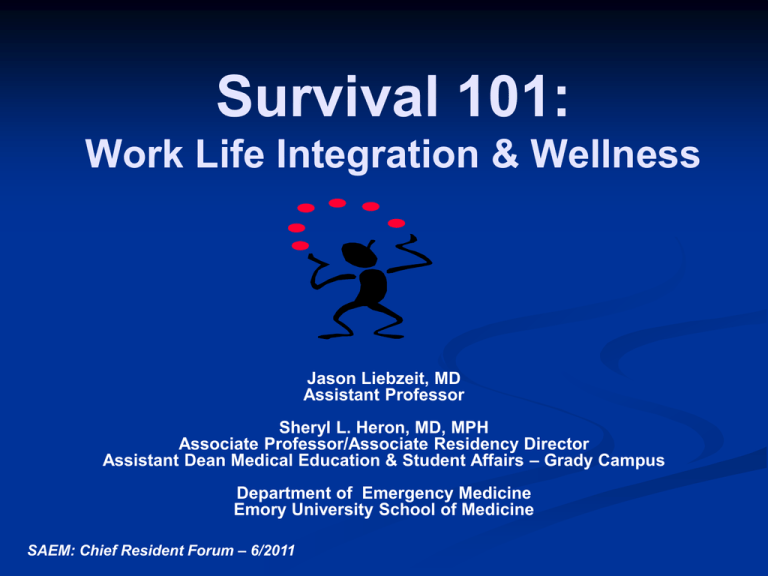
Survival 101: Work Life Integration & Wellness Jason Liebzeit, MD Assistant Professor Sheryl L. Heron, MD, MPH Associate Professor/Associate Residency Director Assistant Dean Medical Education & Student Affairs – Grady Campus Department of Emergency Medicine Emory University School of Medicine SAEM: Chief Resident Forum – 6/2011 Disclosures No commercial financial relationships to disclose Objectives Learners will: Describe the concept of work-life integration Recognize burnout and describe strategies to combat it Formulate a personal plan for self-care during time as a Chief Resident Discuss time management techniques Overview What is work/life integration? What’s next? Career Demands Relationship Demands Attention to Self The Big Picture Work-Life Balance Integration Work Life/Family The End of the Road (or the Beginning) What’s Next? It’s good to be the Chief Academic Community Fellowship Locum Tenems http://www.nytimes.com/2011/04/02/health/02resident.html Burnout Elevated levels of burnout exist among a substantial percentage of surveyed Emergency Physicians Classified broadly in terms of negative perceptions of self, negative practice habits and attitudes, and unhealthy lifestyle. Goldberg et al: Acad Emed 1996 - , Vol 3, 1156-1164 Burnout Self- recognition of burnout Lack of job involvement Negative self- assessment of productivity Dissatisfaction with career Goldberg et al: Acad Emed 1996 - , Vol 3, 1156-1164 Burnout Correlates Sleep disturbances Intent to leave the practice within 10 years Higher levels of alcohol consumption Lower levels of exercise Goldberg et al: Acad Emed 1996 - , Vol 3, 1156-1164 Work-Life Culture What exists? Is it valued? Are there policies? ACEP: Wellness Institution Emory University Department of Emergency Medicine Wellness & Well-Being Committee Emory University Work Life Initiative Strengthen work-life culture for individual and families FSAP My Wellness Family Financial Spiritual Social Professional Physical Mental Relationship Demands You’re almost done, it’s my time now Prime age to begin/expand families Sandwich generation Realities of Life Residency Training & Pregnancy Personal & Family illness Impairment Sleep Hygiene Time Management Enhances Work-Life Integration by: More Control of your life Improved Relationships Increased Productivity Attention to Self Organization Organization Organization Prioritization Resources Creating a Schedule Prioritization Yearly, Monthly, Weekly, Daily Family/Non-negotiables Vacations, Reunions – 1st priority Fill in the Blanks Utilize your Resources Resources Family Colleagues Community Administrative Support You Institutional Resources Human Resources? Dual Career Programs? Family Medical Leave? Mentoring Programs Faculty Staff Assistance Program The Big Picture Keeping the Balls in Motion Monitoring the Balls Dropping the Balls What Keeps You Well? Identify what keeps you grounded Articulate clearly and often Share them with your family and friends Tap into them Benefits of Work-Life Integration To the organization: Measured increases in individual productivity, accountability and commitment Better teamwork and communication Benefits of Work-Life Integration To the Organization: Improved morale Less negative organizational stress Benefits of Work-Life Integration To the individual: More value in your daily life Increased productivity Improved relationships Reduced stress http://www.worklifebalance.com/5steps.html What about us? Survey of 193 ED Physicians (ACEP members) Validated measures of career satisfaction, tolerance for uncertainty, and burnout High level of career burnout No demographic variables were associated with burnout status High anxiety caused by concern for bad outcomes (odds ratio=6.35) was the strongest predictor of burnout Kuhn et al: Annals EM: Feb 09 What about us? 32.1%, exhibited Emotional Exhaustion core symptom of burnout not related to age or type of practice Physicians did not feel anxiety because of: general uncertainty, difficulty in disclosing uncertainty to patients, or admitting errors to other physicians. Kuhn et al: Annals EM: Feb 09 The Good News Despite exhibiting emotional exhaustion, the majority of respondents are satisfied with the career of emergency medicine Kuhn et al: Annals EM: Feb 09 The Good News Random sampling of 1008 Emergency Physicians 2004 - 65.4% EPs reported high career satisfaction, while 12.4% EPs reported low career satisfaction (n = 515) Cydulka & Korte; 2008 – Acad. EMED – June 2008 Career Satisfaction Higher career satisfaction was associated: Teaching settings, research, publication, leadership positions, belonging to medical organizations/medical politics 1/3rd of respondents (33% in 1994, 32% in 1999, 31% in 2004) reported that burnout was a significant problem. Cydulka & Korte; 2007 – Acad. EMED - Abstract Changing the Conversation Burnout Well-Being/Resiliency Develop a shared definition of physician wellness Culture Change More positive Educational Environment Raising awareness of burnout and stigma Enabling prevention strategies Ecklberry-Hunt et al: JGME: Dec 2009 Changing the Conversation Heron et al. Does a curriculum on wellness affect burnout in an Emergency Medicine Training Program (CORD 2011, SAEM 2011) Heron-Liebzeit Protocol Keep a calendar & honor it Learn to say “No” It’s okay to be away There are 24 hours in each day Heron-Liebzeit Protocol Get rid of clutter Monitor the balance Self-check Empower others Honor who & what keeps you well Use your resources Summary Work/life integration is realistic and attainable Burnout is a reality, but you are wellequipped to combat it Prioritize your time Utilize your resources Conclusion Good luck Remember the Big Picture Congratulations

